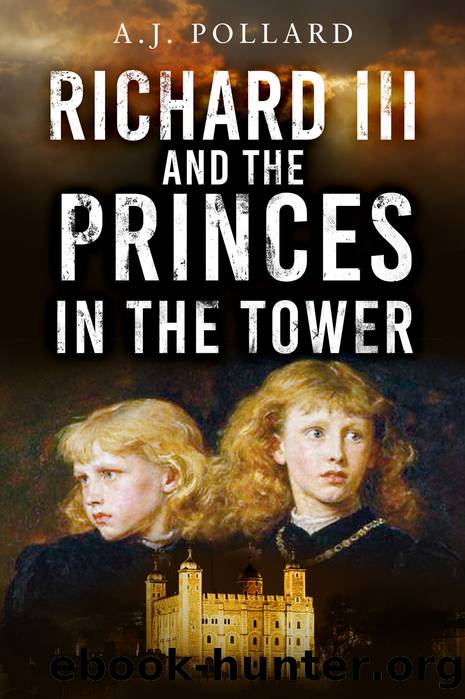Richard III and the Princes in the Tower by A.J. Pollard

Author:A.J. Pollard
Language: eng
Format: epub
ISBN: 9781803996387
Publisher: The History Press
The bones: interpretations based on evidence from photographs and reports written over fifty years ago are fraught with difficulty. One dispute over the age of the skeleton of the elder focuses on the axis, or second cervical vertebra (above). The tip is not ossified and rounded. This normally happens by twelve or earlier, as in the example of a modern eight year old (below left) compared with a modern unossified five year old (below right)
It was because there were so many question marks hanging over the bones interred in Westminster Abbey that they were exhumed and examined in 1933 by Lawrence Tanner, then the archivist of the Abbey, and William Wright. Professor Wright, one of the leading anatomists of his day, with the assistance of George Northcroft, president of the Dental Association, submitted the remains to a modern scientific analysis (modern, that is, in 1933). The conclusion was reached that the urn did indeed contain the bones of two children identifiable with Edward V and Richard of York and that there was a reasonable possibility that the story of suffocation told by More was in its main outline true. In recent years, however, considerable doubt has been cast on the reliability of the Tanner and Wright report.
The first major criticism is that the investigation was conducted and the report written on the profoundly unscientific assumption that the bones did belong to the princes. Wright set out to look for evidence that the bones were those of children between the ages of eleven and thirteen. Moreover, it was taken for granted that both sets of bones were of males â no attempt was made to determine their gender. Instead, effort was concentrated on speculating whether the skulls showed signs of death by suffocation. Even without the benefit of techniques and knowledge available in the last decade of the twentieth century, the investigation was sadly inadequate.
Tanner and Wrightâs report has been subject to the scrutiny and appraisal of several later medical scientists. At least four reassessments have been made of their conclusions since 1955, the two most recent of an extremely detailed and technical kind. Modern conclusions vary. Consensus exists, however, that the statements made by Wright concerning the skeletons, the lengths of certain bones and teeth are consistent with the age of the princes and moreover that the age differential between the two sets of bones would appear to be approximately correct. In all respects large margins of error are nevertheless allowed. It cannot, however, be ruled out that these are the bones of two children of the right age. Disagreement exists as to whether the information recorded by Wright can now be relied upon to show that the two skeletons were related. Whether it is the question of hypodontia (congenitally missing teeth) or the phenomenon of bilateral large wormian bones (whatever they are), opinions differ as to whether consanguinity is a strong possibility or impossible to tell. There is no question, however, that Wright left no information to deal with the vital issue of gender.
Download
This site does not store any files on its server. We only index and link to content provided by other sites. Please contact the content providers to delete copyright contents if any and email us, we'll remove relevant links or contents immediately.
Patriot by Alexei Navalny(333)
Museum of Antiquity by T. L. (Thomas Louis) Haines(274)
The Story of Joan of Arc by Andrew Lang(255)
The Memoirs of Pere Labat, 1693-1705 by Jean Baptiste(231)
The Apollo Moon Missions by Randy Walsh(230)
Richard III and the Princes in the Tower by A.J. Pollard(226)
2,2-Dimethyl-3,4-dihydro-2H-1,4-benzoxazines as isosteres of 2,2-dimethylchromans acting as inhibitors of insulin release and vascular smooth muscle relaxants by Bernard Pirotte & Xavier Florence & Eric Goffin & Philippe Lebrun(224)
Fry The Brain: The Art of Urban Sniping and its Role in Modern Guerrilla Warfare by John West(185)
A History of the Peninsular War, Vol. 5, Oct. 1811-Aug. 31, 1812 by Charles Oman(177)
The Memoirs of Count Grammont â Complete by Hamilton Anthony Count Walter Scott(174)
1916 - The Battle of the Five Empires: 15 May - 28 September 1916 by Benoît Chenu(172)
Life of Napoleon Bonaparte, Volume I. by Walter Scott(172)
Maleficium: Witchcraft and Witch Hunting in the West by Gordon Napier(167)
Rasputin the Rascal Monk by William Le Queux(160)
Famous Fights of Indian Native Regiments by Reginald Hodder(157)
BY MARK Twain, Twain - The innocents at home by 1881(145)
Father Browne's Titanic Album by E. E. O'Donnell(144)
The Thoughts of Marcus Aurelius by Marcus Aurelius(141)
Joanna of Flanders by Julie Sarpy(130)
